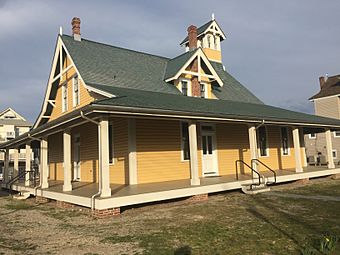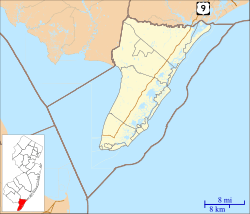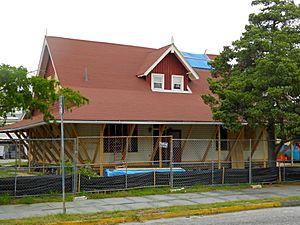Ocean City Life-Saving Station (New Jersey) facts for kids
|
Ocean City Life-Saving Station
|
|

The life-saving station in 2018
|
|
| Location | 801 4th Street, Ocean City, New Jersey |
|---|---|
| Area | 0.29 acres (0.12 ha) |
| Built | 1886 |
| Architectural style | Carpenter Gothic |
| NRHP reference No. | 13000385 |
Quick facts for kids Significant dates |
|
| Added to NRHP | June 14, 2013 |
The Ocean City Life-Saving Station is a special building in Ocean City, New Jersey. It's the only one of its kind left in New Jersey. This station was designed by an architect named James Lake Parkinson. It's built in a style called Carpenter Gothic.
This building is one of only 25 stations built in 1882 for life-saving. It's also one of just six still standing in the entire country! Construction started in September 1885 and finished the next year. This station replaced older ones in Ocean City.
The station was first built very close to the beach. But over time, sand piled up. Now, it's about 1⁄4 mi (400 m) away from the coast. In 1936, the station closed. A bigger station, the Great Egg Coast Guard Station, opened nearby. The United States Coast Guard still owned the building. They used it during World War II to store gear. People who watched the beach for German submarines and spies also stayed there.
In 1945, the Coast Guard sold the station. For 54 years, it was a private home. From 1999 to 2010, a builder wanted to tear it down. They planned to build three duplex homes. But local history groups fought to save it. Ocean City bought the property in May 2010. After a big $1.5 million repair, the station reopened in 2017. Six months later, it became the Ocean City Life-Saving Museum.
Contents
Saving Lives: The Early Days
During the early 1800s, many ships crashed along the New Jersey coast. This happened because lighthouses and maps weren't very good. Shipwrecks were so common that companies hired people to rescue things from the wrecks. Parker Miller, the first person to live in Ocean City year-round, was one of these agents.
A lawmaker named William A. Newell helped pass a law in 1848. This law provided money for lifeboats and stations to help people. The first station in Ocean City was built around 1853 or 1854. It was called "Pecks Beach North." It was near where the current station is today. Another station, Corson Inlet Station, was built in 1855.
These early stations often fell apart because there wasn't enough money for repairs. The rescue crews were often not well-trained. They sometimes took a long time to respond to emergencies.
New Stations and Better Crews
After many shipwrecks in 1870 and 1871, the U.S. government gave money to train crews. They also repaired buildings. In 1872, a larger station was built. It was called Beazley's Station. This station replaced the old 1854 one. Another station, Pecks Beach Station, was also built.
In 1878, Ocean City's three stations became part of the new United States Life-Saving Service. Beazley's Station became U.S. Life Saving Station 30. In 1883, it was officially renamed Ocean City Station. The building started to get old, and its roof leaked. So, in 1884, the Life-Saving Service decided to build a brand new station instead of fixing the old one. They found a flat, grassy piece of land near the beach. It was at 4th Street and Atlantic Avenue.
Building the Station and Its Use
Construction on the new Ocean City Life-Saving Station started on September 17, 1885. It was an "1882-Type" station. This means it followed a specific design by architect James Lake Parkinson. In 1886, the new station was finished. The crew moved in on May 28.
The station was built of wood and was one-and-a-half stories tall. It had a strong foundation of logs, concrete, and brick. The building was rectangular, measuring about 61 ft (19 m) by 55 ft (17 m). Its walls were made of wood planks and shingles. There was also a one-story lookout tower. The roof had asphalt shingles and a brick chimney.
In 1895, a storage shed was added. Over time, the wooden parts of the foundation were replaced with concrete. In 1905, the building got bigger with additions on the north and south sides. A porch was also added.
In 1915, the United States Coast Guard took over the station. It became known as U.S. Coast Guard Station No. 126. Over the years, the beach grew wider. The ocean moved farther away from the station. Because it was so far from the water and in a neighborhood, the station closed in December 1936. The Coast Guard still owned it. They used a larger station nearby.
The building reopened during World War II in late 1941. It was used to store equipment and house people who patrolled the beach. They looked for German submarines and spies. The station closed again in the spring of 1945 after the war ended. During its time helping people, 62 men served at this station. In October 1945, the Coast Guard sold the building. It became a private home. Today, this Ocean City station is the only one of its kind left in New Jersey. It's one of only six in the whole United States.
From Home to Museum: Saving a Piece of History
After the building became a private home, some trees were planted. In the 1940s or 1950s, the lookout tower was taken down. But it was put back in the 1970s to look like the original. The old storage shed was even used as a car garage for a while.
In 1999, the owner wanted to tear down parts of the building. But Ocean City's Historic Preservation Commission said no. A group called Citizens for Historic Preservation filed a lawsuit to stop the building from being moved or torn down. The property was sold to developers who wanted to build new homes. Ocean City's council tried to buy the property, but it didn't happen right away.
In 2001, the property was listed on the New Jersey Register of Historic Places. Ocean City also named it a historic structure. This meant the developers had to follow special rules. For eight years, the developers tried to sell the property. But a group called Saving Our Station fought to protect it.
In 2006, the developers offered to give the property to Ocean City. They also offered money to help move and fix it. The city council approved this plan. After more legal discussions, a fair price was agreed upon in 2009. In March 2010, the Ocean City council approved money to buy the property. The city officially took over the old life-saving station on May 13.
A nonprofit group, U.S. Life Saving Station 30, was formed. They worked to get money to repair the building. In 2011, the New Jersey Historic Trust gave the city $750,000. The city also received other grants to help restore the building.
On April 8, 2013, the Ocean City Life-Saving Station was listed on the state's historic registry. On June 14, it was added to the National Register of Historic Places. Starting in May 2013, work began to restore the building. The goal was to make it look like it did in 1906 and turn it into a museum. The total cost for repairs was about $1.5 million. The work included fixing lights, replacing posts, repairing sidewalks, and improving the roof. They also made it easier for people with disabilities to visit. Damage from Hurricane Sandy in 2012 was also repaired.
On December 31, 2017, the Ocean City Life-Saving Station reopened for the city's New Year's Eve celebration. It officially opened as the Life-Saving Museum on Memorial Day in 2018.





